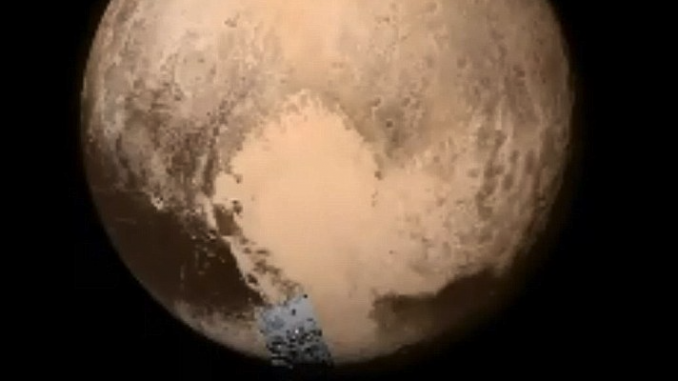
The first images that are high-resolution of Pluto have been beamed to Earth and show shocking 11,000 foot (3,350 meter) ice mountains.
According to a report from The Daily Mail [1]:

BYPASS THE CENSORS
Sign up to get unfiltered news delivered straight to your inbox.
You can unsubscribe any time. By subscribing you agree to our Terms of Use
Latest Video
The remarkable image, released alongside new pictures of Pluto’s moons Charon and Hydra, provides evidence that geological activity is still taking place on the icy world.
Scientists were shocked to see mountains as high as those in the Rockies that likely formed 100 million years ago – mere youngsters relative to the 4.56-billion-year age of the solar system. Nasa says they may still be in the process of building.
Like the rest of Pluto, this region would presumably have been pummeled by space debris for billions of years and would have once been heavily cratered – unless recent activity had given the region a facelift, erasing those pockmarks.
‘We now have an isolated small planet that is showing activity after 4.5 billion years,’ said Alan Stern, New Horizons’ principal investigator. ‘It’s going to send a lot of geophysicists back to the drawing board.’
‘This is one of the youngest surfaces we’ve ever seen in the solar system,’ added Jeff Moore of New Horizons’ Geology, Geophysics and Imaging Team (GGI).
This is the first time astronomers have seen a world that is mostly composed of ice that is not orbiting a planet.
Unlike the icy moons of giant planets, Pluto cannot be heated by the gravitational pull of a larger planetary body. Nasa says some other process must be generating the mountainous landscape.
The mountains are probably composed of Pluto’s water-ice ‘bedrock.’
Although methane and nitrogen ice covers much of the surface of Pluto, these materials are not strong enough to build the mountains. Instead, a stiffer material, most likely water-ice, created the peaks.
‘At Pluto’s temperatures, water-ice behaves more like rock,’ said deputy GGI lead Bill McKinnon of Washington University, St. Louis.
Spencer said that the team has yet to find an impact crater in any of the scans, suggesting Pluto is very compared to the solar system.
The team also announced that the ‘heart’ feature of Pluto will now be known as the Tombaugh Regio, after Clyde Tombaugh, the discoverer of Pluto.
The close-up image was taken about 1.5 hours before New Horizons closest approach to Pluto, when the craft was 478,000 miles (770,000 km) from the surface of the planet. The image easily resolves structures smaller than a mile across.
Prior to the unveiling of Pluto’s image, scientists revealed an image of Hydra, the outermost known natural satellite of Pluto. ‘Surface of Hydra is surprisingly large, said Hal Weaver.
‘Hydra’s surface primarily composed of water ice.’Another image of Charon revealed an impressive variation in geology. ‘Charon just blew our socks off when we had our new image today,’ said Nasa’s Cathy Olkin.
‘We think that the dark colouring can perhaps be a thin veneer. You can see locations in the North Pole were perhaps a crater has dug beneath it and excavated under it.’
Source:


